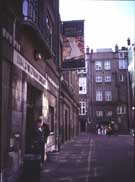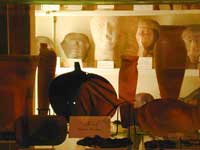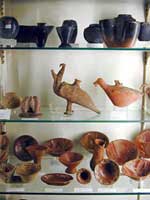

 The Petrie Museum houses an estimated 80,000 objects, making it one of the greatest collections of Egyptian and Sudanese archaeology in the world. It illustrates life in the Nile Valley from prehistory through the time of the pharaohs, the Ptolemaic, Roman and Coptic periods to the Islamic period.
The Petrie Museum houses an estimated 80,000 objects, making it one of the greatest collections of Egyptian and Sudanese archaeology in the world. It illustrates life in the Nile Valley from prehistory through the time of the pharaohs, the Ptolemaic, Roman and Coptic periods to the Islamic period.
The collection is full of 'firsts': One of the earliest pieces of linen from Egypt (about 5000 BC); two lions from the temple of Min at Koptos, from the first group of monumental sculpture (about 3000 BC); the oldest gynaecological papyrus, and the largest architectural drawing, showing a shrine (about 1300 BC).

Costume is another strength of the collection. In addition to the 'oldest dress' there is a unique beadnet dress of a dancer from the Pyramid Age, about 2400 BC, two long sleeved robes of the same date; a suit of armour from the palace of Memphis (awaiting reconstuction), as well as socks and sandals from the Roman period. The collection contains outstanding works of art from Akhenaten's city at Amarna: colourful tiles, carvings and frescoes, and from many other important Egyptian and Nubian settlements and burial sites. The museum houses the world's largest collection of Roman period mummy portraits (first to second centuries AD).
 More than these highlights, though, the collection is uniquely important because so much of it comes from documented excavations. The large typological series of objects (amulets, faience, objects of daily use, tools and weapons, weights and measures, stone vessels, jewellery) provide a unique insight into how people have lived and died in the Nile Valley.
More than these highlights, though, the collection is uniquely important because so much of it comes from documented excavations. The large typological series of objects (amulets, faience, objects of daily use, tools and weapons, weights and measures, stone vessels, jewellery) provide a unique insight into how people have lived and died in the Nile Valley.
The museum is open to the public Tuesday to Friday 13.00 - 17.00 and Saturdays 10.00 - 13.00. Admission is free. Individual researchers and groups are welcome outside these hours, by appointment. For further details see www.petrie.ucl.ac.uk
The museum plans to move to purpose built accommodation in a new building, the Panopticon, due to open in 2008. For further details see www.ucl.ac.uk/panopticon.